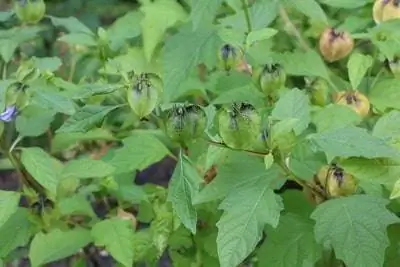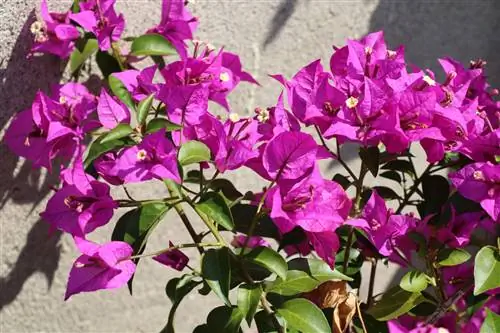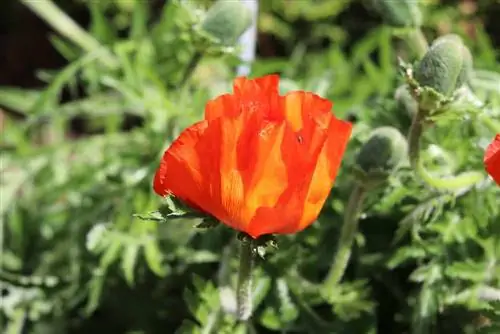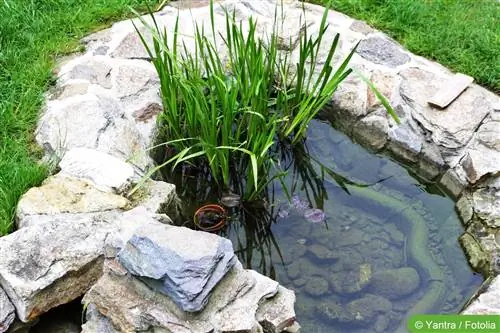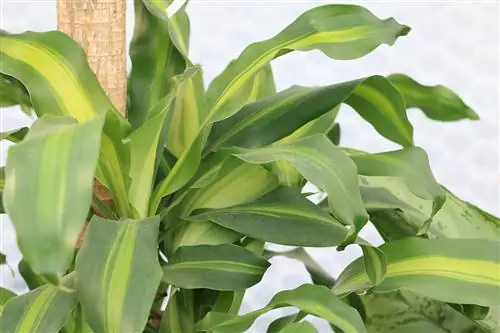- Author admin [email protected].
- Public 2023-12-17 03:39.
- Last modified 2025-06-01 06:48.
A tropical climbing plant that has star qualities in terms of growth speed and whose fruits are so small that they ripen even in fairly untropical Germany - fans of decorative exotic plants and delicious exotic fruits should definitely try it out. Below you will find out that this climbing plant is called Cape gooseberry or physalis, how you can get such a physalis plant for free and how you care for and overwinter this physalis:
Physalis cultivation profile
- The Physalis comes from the South American tropics/South Tropics
- Grows in the German garden from a soil temperature of 10 °C
- But needs every available ray of sunshine for good growth
- Then maybe a lot of Cape gooseberries can be harvested in Germany
- Which are known as “Physalis” because the trade sells the fruits under the genus name of the plant
- With their pretty paper wrappers, the orange balls have long been decorative stars, but are also delicious and he althy
- “Perhaps they can be harvested” because physalis only ripen in our country under favorable conditions
- The (even pre-grown) young plants must be planted out as soon as the garden soil is warm enough
- The sun must shine often and for a long time throughout the summer and autumn
- But it's worth trying, and there are tricks for making early-harvested fruit ripen
Helpful in advance: Organize Physalis
A “Cape” gooseberry native to South America; delicious physalis recipes and physalis poison warnings; a fruit called Physalis and many plants that have the word Physalis in their name - the topic of Physalis could use a little structuring:
1. The Cape and the Physalis
The Cape of Good Hope is still in Africa, but was visited by the South American Physalis a long time ago: It is said to have been introduced to South Africa by Portuguese sailors, and they had their best time in the 15th century. Century At the Cape of Good Hope, the “gooseberry” brought by the foreign guests grew so well that it was planted in many fields and thus became the “Cape gooseberry”.
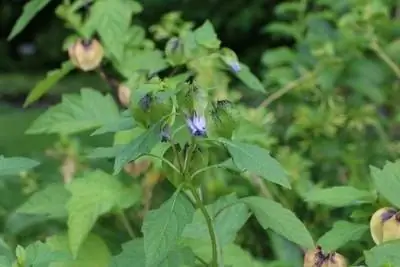
2. Poison or not poison
For people who love their relatives, a crucial Physalis question that simply cannot be answered positively or negatively because Physalis are nightshade plants. It's probably already ringing in your back room, keyword tomatoes and potatoes, you shouldn't eat the leaves or green parts of the fruits because they contain poisonous solanine.
It's exactly the same with Physalis, depending on the species, more or less poisonous plant parts (sensitive people react to skin contact) and sometimes also fruits that can only be eaten cooked. But Cape gooseberries can be eaten raw as long as you only eat the berries.
3. Physalis fruit or plant
There are many plants called Physalis because “Physalis” is the scientific name of the genus. This genus (bladder cherries, “Physalis” means “bubble” in Greek) currently includes 134 Physalis, plus the respective unique species name, the Cape gooseberry is called, for example. E.g. botanically complete “Physalis peruviana”.
There is a fruit called Physalis because the fruit of this Cape gooseberry is usually “addressed with its genus name” in the trade (although there are enough German names in circulation with Cape gooseberry, Andenberry, Andean cherry, Peruvian bladder cherry, Jew cherry).
Planting Cape Gooseberries
An absolutely pleasing feature of the Cape gooseberry: If you have planted the young plant in the right location, you have completed the most important part of the care. Above all, this should be a warm and sunny location:
- Happy as a windbreak and heat reflection on a house wall
- Definitely in full sun
- Physalis tolerate direct sunlight even during midday
- Acclimatise young plants to the sun
- In the garden, trees, hedges and outbuildings can provide the necessary wind protection
- Planting in warm soil, a soil temperature of 22 °C would be optimal
- Planting out earlier is possible, from around 16 °C, but then it can't get any colder
- In addition, the Physalis will only start to grow properly at 20 °C
- In areas at risk of late frost, wait for Ice Saints in May
- Place at a distance of approx. 80 cm, some cultivars are very strong growers
- If the ground is warm enough, planting should be done immediately
- Query the soil temperature every day in spring: www.dwd.de/DE/leistung/bodentemperatur/bodentemperatur.html
Tip:
We read again and again that Physalis can be grown in buckets, even in pots. You can, a Physalis will probably produce masses of green leaves in the last pot in dark corners. But the sun children will only produce edible fruit in this climate if they are in large containers that spend the summer season in a cozy outdoor location under full sunlight.
If the best location doesn't have the best soil waiting for the physalis, you don't care much. The young plants like to grow in sparse forests in their homeland, but also easily colonize disturbed locations up to “ecologically destroyed” ruderal areas. The fact that the Physalis are able to green such precarious locations as ruderal vegetation (first settlers) shows the undemanding nature of the Physalis in relation to the soil conditions.
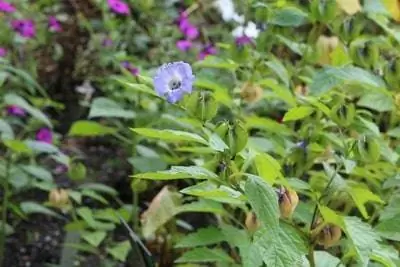
The Physalis usually copes well with poor garden soil. Physalis in over-fertilized soil or natural soil that is too nutrient-rich can become a problem because, although they have record-breaking growth, they obviously do not consider flower and fruit production to be necessary under such paradisiacal circumstances. You can make such soils less nutrient-poor by adding sufficient amounts of coarse sand before planting.
Prefer Physalis or sow directly
The ripening time of the physalis is actually a little longer than the necessary heat is available in our climate. With climate change, our climate is approaching ideal Physalis conditions, but it is currently only getting really tropically warm in parts and for a short time.
If you sow Physalis directly into the bed as soon as the ground is warm enough (mid-April to mid-May), the first Physalis will fruit in mid-October and the last in mid-November. In our climate, even with the post-ripening trick described below, this is not the most successful way to harvest ripe and aromatic physalis.
If you can purchase the first young plants in friendly regions in mid-April and immediately plant them in warm garden soil - you will lose on average a month in which the plants can get fresh air or your garden soil and its microbiotic composition have to get used to. Brings the first fruits in mid-August; If early autumn cold causes an early harvest, they have to be ripened indoors using tricks. Because only ripened fruits on the plant carry the full aroma, experienced Physalis growers prefer to grow the plants indoors in order to plant them outdoors at the optimal time to be able to. How to proceed:
- Sow seeds as early as possible
- In a mix of cultivation and garden soil or normal potting soil + garden soil + sand
- The light germinators are only lightly pressed onto the moist earth, not “buried in the earth”
- Moisten the soil evenly (not soaking wet9
- Close the indoor greenhouse lid, cover the cultivation pots with foil etc.
- If water droplets form, ventilate because the humidity is too high
- Place on the window sill above the heater
- In front of a window through which the sun shines all day if possible
- Minimum germination temperature 22 °C, if necessary to guarantee using a heating mat under the cultivation pot
- • It takes 8 - 14 days for seedlings to appear
- Separate when the second pair of leaves appear (first true leaves after the cotyledons)
- Select the strongest young plants
- Tightly shorten the roots of these so that they branch out better
- Place young plants in a sunny place without cover
- Gradually get used to fresh air until planting out
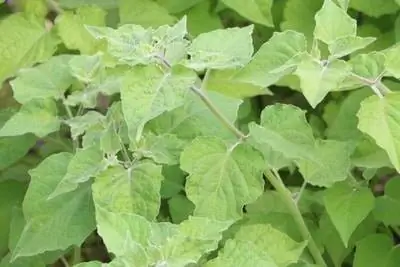
If you started pre-growing the seeds in mid/late January, you can expect the Physalis to fruit in July and have enough aroma to harvest in August/September.
You can get seeds in the supermarket, just at the best time to start growing, the imported commercial fruits are in high season and are cheaper than the rest of the year. The more Physalis you consume in winter, the more young plants you can grow. This type of seed collection is unbeatably inexpensive and is certainly one of the most fun ways for families with children to demonstrate the origins of our food.
With the “direct form of seed production” you cannot select a specific cultivar because the Physalis fruits are not traded in varieties. But you were able to try beforehand what your harvest would taste like and you know for sure that your seeds were not treated with any substances or treated in any other way that you do not want to have in your plant. However, only the purchase of organic quality seeds guarantees ecologically sound parent plants; You can find these and every other type of Physalis seeds (+ young plants) on the Internet.
Care instructions
The prerequisite for a good harvest is that you take good care of the plants until then; which isn't very difficult once you've gotten this far:
- Cape gooseberries really need a lot of water because they grow incredibly fast
- In a short time, 1 to 2 meter high shoots and soon a lot of biomass to be supplied
- But quite sensitive to dryness
- The roots of Physalis should never be completely dry
- Mulching with small organic material helps to prevent this
- The climbing shoots are initially very tender and thin
- In this situation, a climbing aid can provide support and show the plant the way
That's basically it for the care of the Physalis, which is normally only cultivated as an annual (see below for wintering); The low nutrient requirements of the Physalis have already been explained above in “Planting Cape Gooseberries”.
Harvesting and storage
When many small round balls appear (hopefully in July), the hope for a harvest increases - nothing more, because the Cape gooseberries are still bright green and taste just as green as they look. The aroma and he althy ingredients have only accumulated when the berry skin and interior are beautifully orange, without the slightest hint of green. In our climate, the Physalis is “doubly prevented” from developing this maturity: the sun has been shining for shorter and shorter days (since June 21st), and at the latest since the beginning of autumn a quarter of a year later, the temperatures no longer meet the heat requirements of a Physalis.
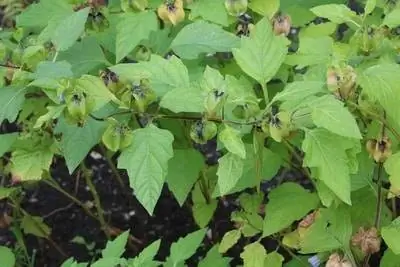
If it works and the physalis shows the right color, you can snack on he althy fruits directly from the plant for a while (most recommended consumption option), decorate every dessert with physalis, save the seeds from the rest for the next season or Dry Cape gooseberries and use them like raisins. If not, you might be able to save something with the following tip:
Tip:
Physalis do not ripen when stored. A trick comes into play at the interface between “fruit on the tree” and “fruit in the fruit bowl”: If you have to harvest half-ripe Physalis because the night temperatures reach 10 °C, the absolute minimum temperature for the plant, simply “harvest” the entire branch with fruit and hang it up dry and airy. The fruits last for about two weeks and draw a few nutrients from the shoots during “storage”. Since the fruits hang at the end of the shoot, cut away about half of the shoot. If the Physalis are overwintering, you will anticipate the spring pruning of the fruit shoots.
Wintering
The Cape gooseberry can overwinter outdoors from hardiness zone 10a. Significantly warmer than here, in Germany 8a is the warmest winter hardiness zone, the Cape gooseberry has to overwinter in the bucket:
- Transplant in good time (get used to it!)
- Move indoors the day before the first frost
- Fruits that have just ripened remain on the plant
- Fruitless or harvested shoots can now be cut back to a maximum of 1/3
- This is how many large Physalis fit into a small winter quarters
- Location for wintering: bright, at least 10 °C warm, optimal 15 °C
- If it is light enough, the Physalis overwinters as an evergreen at home
- If there is not enough light, it throws off the leaves and reduces the metabolism to the minimum
- There is some water in both cases, but the leafless physalis evaporates via the shoots but really only in “droplets”
Physalis peruviana are offered in several cultivars, among which no clear favorites can be identified. There are supposed to be Physalis varieties that can overwinter outdoors in our country (in friendly regions, with winter protection), but no reports of experiences about outdoor overwintering in Germany can be found. If you can't find a suitable place to overwinter, you can also root cuttings of the last Physalis and overwinter.
Overwintered pot physalis are cut back by at least half of the shoots (when harvesting, at the latest in early spring) and they should sprout again in spring. As a reward for a successful wintering, the Physalis will produce its first fruits in July next season.

